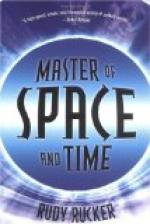Under the influence of the electric waves set up from the spark-gap those tiny particles so arranged themselves that they would readily carry a current between the plugs. By placing these plugs with their platinum terminals in circuit with a local battery the current from this local battery was given a passage through the coherer by the action of the electric waves coming through the ether. While these waves themselves were too feeble to operate a receiving mechanism, they were strong enough to arrange the particles of the sensitive metal in the tube in order, so that the current from the local battery could pass through them. This current operated a telegraph relay which in turn operated a Morse receiving instrument. An electrical tapper was also arranged in this circuit so that it would strike the tube a light blow after each long or short wave representing a dot or a dash had been received. Thus the particles were disarranged, ready to array themselves when the next wave came through the ether and so form the bridge over which the stronger local circuit could convey the signal.
Marconi further discovered that the most effective arrangement was to run a wire from one terminal of the coherer into the ground, and from the other to an elevated metal plate or wire. The waves coming through the ether were received by the elevated wire and were conducted down to the coherer. Experimenting with his apparatus on the posts in the garden, he discovered that an increase in the height of the wire greatly increased the receiving distance.
At his sending station he used the exciter of his teacher, Professor Righi. This, too, he modified and perfected for his practical purpose. As he used the device it consisted of two brass spheres a millimeter apart. An envelope was provided so that the sides of the spheres toward each other and the space between was occupied by vaseline oil which served to keep the faces of the spheres clean and produce a more uniform spark. Outside the two spheres, but in line with them, were placed two smaller spheres at a distance of about two-fifths of a centimeter. The terminals of the sending circuit were attached to these. The secondary coil of a large induction coil was placed in series with them, and batteries were wired in series with the primary of the coil with a sending key to make and break the circuit. When the key was closed a series of sparks sprang across the spark-gap, and the waves were thus set up in the ether and carried the message to the receiving station.
As in the case of his receiving station, Marconi found that results were much improved when he wired his sending apparatus so that one terminal was grounded and the other connected with an elevated wire or aerial, which is now called the antenna. By 1896 Marconi had brought this apparatus to a state of perfection where he could transmit messages to a distance of several miles. This Irish-Italian youth of twenty-two had mastered the problem which had baffled veteran scientists and was ready to place a new wonder at the service of the world.




